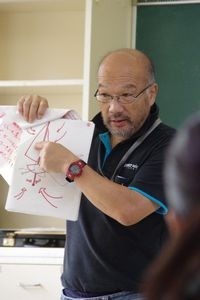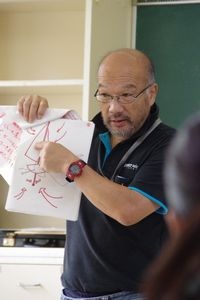Many survivors of the Great East Japan Earthquake continue to live under uncertain conditions in shelters and temporary housing. During the summer, AAR Japan worked to make their lives as comfortable as possible in the heat and humidity. Now they are focusing their efforts on preparations for the winter.
In September, AAR Japan provided heaters to survivors in temporary housing on the Oshika Peninsula, part of Ishinomaki. Some survivors said that they had been worrying about how they would get through the coming winter given the short supply of heaters in the area. In order to ease their concerns, AAR Japan provided heaters to 80 families in shelters in Ayukawahama, an area where many elderly people live.
Residents of temporary housing units chose a leader to coordinate with AAR Japan for the distribution of the heaters. Through the selection of a community leader, it is hoped that the residents will be encouraged to continue to work together to get through this difficult time. AAR Japan provided emergency supplies to a total of 965 people in 9 shelters from July 13 to September 7, and will continue its efforts to support survivors and enable them to live healthier and warmer lives during the coming winter.
 Peace Winds Japan (PWJ) has been providing safe places to play for children in Kesennuma and Rikuzentakata at evacuation centers, temporary housing, and after-school daycare centers. It has conducted various sports and arts activities to alleviate psychosocial stress after the disaster, as well as to encourage self-expression. On September 26, since it has been over six months since the tsunami disaster, PWJ organized a workshop for the instructors in Kesennuma who deal with children directly.
Peace Winds Japan (PWJ) has been providing safe places to play for children in Kesennuma and Rikuzentakata at evacuation centers, temporary housing, and after-school daycare centers. It has conducted various sports and arts activities to alleviate psychosocial stress after the disaster, as well as to encourage self-expression. On September 26, since it has been over six months since the tsunami disaster, PWJ organized a workshop for the instructors in Kesennuma who deal with children directly.
After-school daycare centers in Japan are not funded by the Ministry of Education, so they are less likely to receive government funding and aid compared to other educational institutions in Japan. Moreover, those who attended the workshop were having difficulty finding ways to get the children to play fully because of the limited space they have now. They also have to deal with the increased number of children registered at the daycare centers due to their parents going back to work or getting new jobs. The workshop’s objectives were to introduce ways to solve these problems. PWJ introduced the “Moving Forward” program at this workshop, which is designed not only to give children physical activity, but also supports their mental strength, encouraging them not to give up and enhancing teamwork. PWJ briefly explained the basic component of this concept, and then the participants actually played one of the games introduced by this program. The game was modified for the limited space available outside. Following the workshops, one participant said, “After the earthquake, we (the instructors) tried not to bother as much when children misbehaved. Yet, we were discussing whether we should start disciplining children when it’s necessary. After the workshop, we were encouraged because it seemed that we were right on track for dealing with children here.” Many appreciated the opportunity to exchange information and opinions with PWJ staff and with instructors working at other afterschool daycare centers in Kesennuma.

